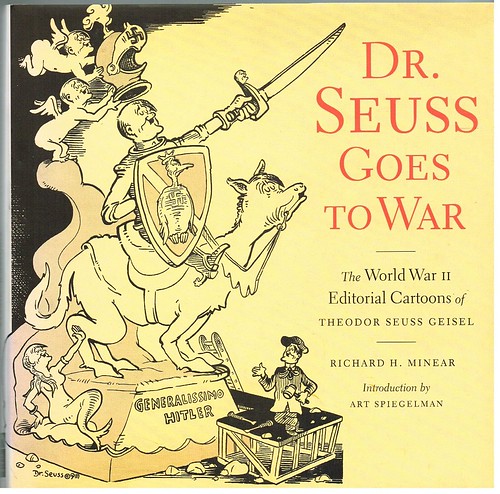Geisel did three cartoons a week for PM and occasional drawings for the Treasury Department, the War Production Board, and Nelson Rockefeller’s Committee on Inter-American Affairs, but after the United States got into the war, he felt so out of the main current of events that at the end of 1942 he decided to join the armed forces. He was presently stationed in California, as an Army captain attached to Frank Capra’s celebrated wartime documentary-film-making unit, for which he wrote and directed scripts calculated to elevate G.I. morals and morale. In the fall of 1944, Geisel was shipped to Europe for a spell, in connection with his film work, and at General Omar Bradley’s headquarters in Luxembourg, he ran into Ingersoll, by then a lieutenant colonel. Ingersoll said he supposed that Geisel, like most Stateside tourists, would like to have a peek at some actual fighting while he was in the area—without, of course, getting too dangerously exposed. Unfolding a top-secret map, he studied it carefully and circled “Bastogne.” Then he summoned a jeep and urged Geisel to ride on up there and take in the sights. Geisel was trapped for three days in the Battle of the Bulge, eventually being rescued by the British. “Nobody came along and put up a sign saying, ‘This is the Battle of the Bulge,’ ” he explained later. “How was I supposed to know? I thought the fact that we didn’t seem to be able to find any friendly troops in any direction was just one of the normal occurrences of combat.”
Shortly before the first atomic bomb was exploded, Geisel returned to California, where he was ordered to come up with another film for postwar occupation troops—one that would keep them on the alert by reminding them that inattention could lead to a third world war. “Make that third war a real doozy, Geisel,” he was told. Seeking inspiration, he leafed through the magazine section of a recent Sunday Times, where his eye was caught by an article suggesting that there was enough latent energy in a tumbler of water, if man could ever figure out a way of harnessing it, to blow up half the earth. Without further ado, or further research, Geisel knocked out the draft of a script suggesting the possibility of unimaginably devastating explosions, and passed it along to his superiors. Two days later, the Pentagon was on the phone, urgently asking where he’d got his facts.
“From the Times,” he replied.
“Burn your source of information, Geisel,” came the command.
“Burn the Times?” he asked.
“Yes, and report by phone as soon as you’ve carried out your orders,” he was told.
“I had long since thrown away the copy of the paper in question,” Geisel recalls, “but I wanted to be a good soldier, so I rushed my most reliable sergeant to an out-of-town news dealer, and he bought me a copy of the latest Times. We put it in a metal bucket and all marched out into a courtyard and stood in formation and gave the Boy Scout salute while a trusted lieutenant lit a match to it. Then I called Washington and said, ‘Mission accomplished, sir. We have burned the Times.’ ‘Well done, Geisel,’ I was told, and then they went on with the war.”
Mustered out, as a lieutenant colonel, early in 1946, Geisel proceeded to divide his time for several years between children’s books and motion pictures. With his wife, he wrote a documentary film about Japan, “Design for Death,” which won an Oscar in 1947, but which soured its authors on Hollywood values. The object of the picture was to show that the Japanese were at heart not much different from any other human beings (“A person’s a person, no matter how small”), and that they had allowed themselves to be dominated by a gang of ruthless leaders. One sequence, of which both Geisels were particularly fond, as illustrative of the serenity of Japanese culture, was devoted to sixteenth-century Japan. No actors were involved—just fog and water, with a muted tone poem as the musical background. While looking at some rushes one evening, the Geisels were horrified to discover that one of the producers had livened up this tranquil stretch with shots of American tanks barrelling through a crowd of shrieking Japanese. The producer refused to delete the tanks, on the ground that, anachronism or no anachronism, they gave the dreary old century some vitality. Just before the picture was released, the Geisels sneaked into a cutting room and, abetted by a film editor, snipped out the lively footage. The producer had the last word, though. Weeks later, when the Geisels passed a theatre where the film was playing, they found it advertised with posters that showed terrified white women in ripped chemises being carted off in cages by transparently ill-intentioned Japanese soldiers.
